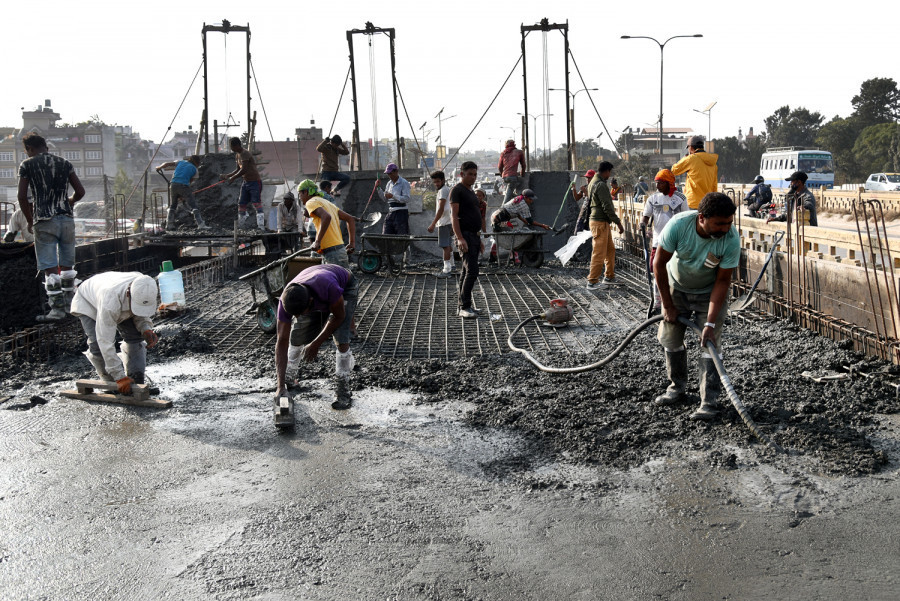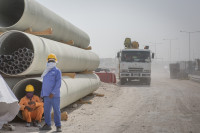Columns
What ails construction projects in Nepal?
Taxpayers have every right to expect roads and bridges that do not get washed away with the first rain.
Rudra Sharma Aryal
Rain, sun or snow, most of Nepal remains a huge haphazard construction site throughout the year. Also, one doesn’t need to be an "all knowing" engineer or a mega builder or top contractor to point out that all’s not well in what’s going on in the name of construction: It’s disappointing and not a happy scene, certainly not a matter of pride. Even if there’s an abundant supply of manpower, machines, materials, methods and money, why do most projects start floundering before taking wing, or why do construction works get excruciatingly delayed beyond redemption?
A typical project typically comprises five traditional phases, progressing from the initial phase to planning to execution, monitoring and controlling, and closing phase. It has to pass through diverse departments like indifferent governmental agencies, unsympathetic bureaucracy, profit-mongering financiers, scheming insurance companies, project consultants, engineers, lawyers, contractors of varying sizes and specialities, equipment manufacturers and assorted suppliers.
Science and art
Managing any project is a matter of science and art: It’s challenging, but proven methods are there. Scientific use of tested project management techniques and tools can be applied as elsewhere in the world for project delivery. There is no lack of talent. The same Nepali project managers, engineers and technicians are part of the skilled workforce working overseas with other nationals, and completing most of the projects on the dot. There can’t be excuses for other resource crunches, too, anyway billions are being pocketed unscrupulously and flushed down the drain with shoddy work—all in the name of the development of Nepal.
People expect quality work and superior output within schedule and without cost overruns as planned. Taxpaying citizens have every right to expect roads and bridges that do not get washed away with the season’s first rain. Electric poles and electric cables that don’t lean dangerously and dangle over the passers-by, and brand-new hydropower plants that don’t screech to a halt as soon as the prime minister leaves after the ribbon-cutting inauguration.
The answer lies in identifying the problem areas and making an action plan before project initiation. Past experiences show some fundamental reasons why mostly EPC (engineering, procurement and construction) projects don’t progress as planned and envisioned. If we can correct these underlying flaws at the very outset, we can avoid most project bottlenecks and failures. The only problem is, they aren’t always that easy to identify before it’s too late, nor are they that simple to correct midway through the project.
Project leadership is a critical and most important factor. Yes, it’s the number one condition for the success or failure of a project. When it comes to construction management, a strong project manager equipped with professional capabilities with a strong, commanding personality who can beat the system and overcome the hurdles on the way can do wonders. But the person chosen to lead the project must have solid backing and cooperation, especially of the higher-ups and must possess some professional attributes. Indispensable qualities are a practical construction project management background, the right temperament to deal harmoniously with all project stakeholders and all ranks of people along the way, and the ability to focus on the big picture without getting entangled in daily chores and mundane activities.
Proper communication is another essential feature that makes a project a success if handled professionally. When we say communication, it’s not only a subject between the clients and the contractors—all stakeholders must be kept in the loop for trouble-free running of the project. It’s the responsibility of higher management that working drawings, plans and technical specifications must be available in each team member’s hands at the beginning of the project itself, so that each can deal independently with their work responsibilities and handle the different parties and meet their concerns. Regular project review meetings with the team members and stakeholders are practical tools, but meetings for the sake of meetings only with no fixed schedule or clear purpose are a waste of time. They interrupt the work momentum and unnecessarily distract those serious souls who are critical for reaching the project milestone.
Even highly educated managers and executives in Nepal are pretty sceptical about sharing work-related information and working plans promptly, even to those for whom they are intended, thereby harming overall project health. Sharing relevant information is the hallmark of a dynamic project manager, and it in no way erodes the power and importance of any leader. Except for strategic business secrets, all the project communication must be open and accessible to all team members and relevant stakeholders. When delegating a task to junior team members, the terms and conditions should be laid out clearly, mentioning to what extent they are allowed to take decisions in their daily duties.
The worst thing that can happen to any construction project is ignoring the initially agreed work scope of the contract agreement. The original plan is made to execute the work within time, within budget, and by meeting all technical specifications. Adding work or changing work activities at the later stages can derail the original plan. There needs to be a robust scope change management system in place to take care of such unexpected situations. Proper monitoring of the budget based on the initially planned estimates for each component of the work is a sure-shot way of completing the work within the budget.
Over-zealous unions
Dirty party politics and over-zealous labour unions also play havoc with the health of construction projects and industrial sectors, vitiating the overall work atmosphere. Especially in our Tarai belt, it can be seen that casual employment of construction workers and industrial labourers from across the border is less of a headache and more cost-effective than employing the politically vocal and more demanding residents from the surrounding areas. The less the politics, the better the chance of projects moving on the right track with the added benefit of employment opportunities for interested locals.
Nepal has a high stake in construction as it occupies a prime role in our national economy, giving employment and livelihood to a good percentage of our population. It’s an accurate economic barometer of our national prosperity, and is a key engine of growth. But with all resources at our disposal and armed with the right work attitude and strong determination, there is no question of engineering projects not reaching the milestones and targets. It’s not at all a tall order; it’s achievable and within our reach.




 8.12°C Kathmandu
8.12°C Kathmandu













%20(1).jpg&w=300&height=200)

